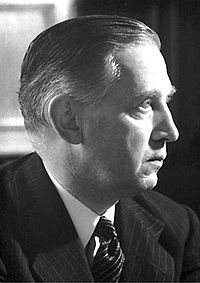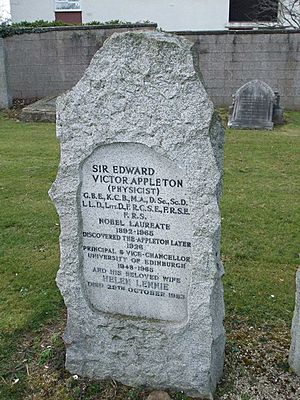Edward Victor Appleton facts for kids
Quick facts for kids
Edward Victor Appleton
|
|
|---|---|

Appleton in 1947
|
|
| Principal and Vice-Chancellor of the University of Edinburgh | |
| In office 1 February 1949 – 21 April 1965 |
|
| Chancellor | Victor Hope, 2nd Marquess of Linlithgow Prince Philip, Duke of Edinburgh |
| Preceded by | Sir John Fraser |
| Succeeded by | Lord Swann |
| Personal details | |
| Born | 6 September 1892 Bradford, West Riding of Yorkshire, England |
| Died | 21 April 1965 (aged 72) Edinburgh, Scotland |
| Alma mater | St John's College, Cambridge |
| Known for | Ionospheric Physics Appleton layer Appleton–Hartree equation Demonstrating existence of Kennelly–Heaviside layer |
| Awards | Nobel Prize in Physics (1947) Fellow of the Royal Society (1927) Hughes Medal (1933) Faraday Medal (1946) Chree Medal (1947) Royal Medal (1950) Albert Medal (1950) IEEE Medal of Honor (1962) |
| Scientific career | |
| Fields | Physics |
| Institutions | NPL University of Edinburgh University of Cambridge King's College London |
| Academic advisors | J. J. Thomson Ernest Rutherford |
| Notable students | J. A. Ratcliffe Charles Oatley Karl George Emeléus |
| Influenced | Miles Barnett |
Sir Edward Victor Appleton (born September 6, 1892 – died April 21, 1965) was an English physicist. He won the Nobel Prize in Physics in 1947 for his important work. He was a pioneer in understanding how radio waves travel through the atmosphere. He studied and worked at Bradford College from 1909 to 1911.
He is famous for proving that a special layer exists high up in Earth's atmosphere, called the ionosphere. He showed this with experiments he did in 1924. His discoveries helped develop radar and improve radio communication around the world.
Contents
About Edward Appleton
Edward Appleton was born in Bradford, England. His father, Peter Appleton, was a warehouseman. Edward went to Hanson Grammar School.
In 1911, when he was 18, he received a scholarship to attend St John's College, Cambridge. He graduated in 1913 with top honors in Physics. In 1915, he married Jessie Longson and they had two children.
During the First World War, he served in the military. After the war, in 1920, Appleton became an assistant physics demonstrator at the Cavendish Laboratory. He later became a physics professor at King's College London (1924–1936) and the University of Cambridge (1936–1939).
From 1939 to 1949, he was the secretary of the Department of Scientific and Industrial Research. He was knighted in 1941. In 1947, he received the Nobel Prize in Physics for his work on the ionosphere. This research was very important for the development of radar.
From 1949 until his death in 1965, Appleton was the Principal and Vice-Chancellor of the University of Edinburgh. He gave a series of radio talks in 1956 called Science and the Nation, where he talked about science in Britain.
Sir Edward Appleton died on April 21, 1965, in Edinburgh. He is buried in Edinburgh's Morningside Cemetery.
Discovering the Ionosphere
Appleton noticed something interesting about radio signals. A radio signal from a transmitter about a hundred miles away would stay strong during the day. But at night, the signal would change a lot. He thought this meant two radio signals were arriving. One signal traveled along the ground. The other signal was reflected by a layer high up in the atmosphere. The changing strength of the signal was caused by these two waves interfering with each other.
Scientists before him, like Oliver Heaviside and Arthur E. Kennelly, had suggested that such a reflecting layer might exist. They thought it could explain how Guglielmo Marconi sent radio signals across the Atlantic Ocean. Calculations showed that radio waves should just shoot off into space without such a layer.
Appleton's Experiments
Appleton wanted to prove this reflecting layer existed. He looked for changes in radio signals around sunset. He believed these changes were due to the interference of two waves. He needed to show that the second wave was coming down from the ionosphere.
He designed an experiment with two ways to show the ionosphere's effect. Both methods helped him figure out the height of this reflecting layer.
The Frequency Modulation Method
One method was called "frequency modulation." This method uses the fact that the ground wave and the reflected wave travel different distances.
Imagine the ground wave travels a distance 'h' and the reflected wave travels a longer distance 'h. The difference in their paths is 'D'.
If the waves arrive at the receiver perfectly in sync, the signal is strong. If they arrive out of sync, the signal becomes weak or fades. Appleton and his team changed the wavelength (or frequency) of the radio signal. They listened for when the signal became strong again. By knowing how much they changed the wavelength, they could calculate the path difference 'D'.
Using this path difference, they could then figure out the height of the reflecting layer. In 1924, Appleton and his team used the BBC broadcasting station in Bournemouth to change wavelengths after evening programs. They had a receiving station in Oxford. This experiment showed that the waves were being reflected from about 56 miles (90 km) up.
Confirming the Reflection
The frequency modulation method showed a reflecting point. But it didn't prove the waves were coming from above. They could have been reflected from hills. So, Appleton used a second method. This involved finding the angle at which the reflected signals arrived at the receiver. This method confirmed that the waves were indeed coming from high above the Earth. The heights calculated matched those from the frequency modulation method.
Understanding the Ionosphere's Structure
Appleton's success opened up a huge new area of study. He developed a theory to understand how this part of the atmosphere worked. He showed that the Kennelly–Heaviside layer was full of charged particles, or "ions," which made it electrically conductive. This is why it's called the ionosphere. He found that free electrons were causing this ionization.
He also discovered that radio waves above a certain frequency could pass through this lower layer. But these penetrating waves would then reflect back from an even higher layer. This showed that the ionosphere was more complex than first thought.
- The lower layer was called the E-Layer. It reflected longer wavelengths and was found at about 78 miles (125 km) up.
- The higher layer, with more electrons, was called the F-Layer. It could reflect much shorter wavelengths that passed through the E-Layer. It is located 186 – 248 miles (300 – 400 km) above Earth's surface. This F-Layer is often called the Appleton Layer. It helps with most long-range shortwave radio communication.
Why Signals Change Day and Night
Appleton also explained why radio signals changed so much between day and night. During the day, sunlight causes air molecules to become ionized even at lower altitudes. At these lower heights, the air is dense, so there are many free electrons. These electrons absorb radio waves, making reflections weak.
However, when the sun sets, the charged particles slowly combine back into normal molecules. This means fewer free electrons, so less absorption. Waves can then be reflected strongly enough to be noticed. The height where reflection happens also changes as the sun sets, moving higher up. This explains the fading and changes in radio signals at night.
Impact of Appleton's Work
Appleton's work on the ionosphere might seem simple at first, but it led to many important discoveries. By the end of his life, observatories around the world were mapping these reflecting layers. Scientists found links between the ionosphere and the 11-year sunspot cycle, as well as the aurora borealis (northern lights).
His research became very important during the Second World War. Magnetic storms, which affect the ionosphere, could cause radio blackouts. Thanks to Appleton's work, scientists could predict when these blackouts would happen. This allowed communication to be switched to different wavelengths that would be less affected.
Radar was another crucial invention that came from Appleton's work. His research involved figuring out the distance of reflecting objects using radio signals. This is exactly how radar works! He even helped develop a "pulse method" to measure the ionosphere, which was later adapted by Robert Watson-Watt to detect airplanes.
Today, understanding the ionosphere is still important for communicating with satellites. Scientists need to choose the right frequencies so that signals reach satellites without being reflected or bent away.
In 1974, the Radio and Space Research Station was renamed the Appleton Laboratory to honor Sir Edward. He had done so much to make the UK a leader in ionospheric research.
Honours and Awards
Sir Edward Appleton received many awards for his scientific work:
- Fellow of the Royal Society (1927)
- Foreign Honorary Member of the American Academy of Arts and Sciences (1936)
- Nobel Prize in Physics (1947)
- Faraday Medal
- Hughes Medal
- Royal Medal
- Chree Medal
Several places and awards are also named in his honour:
- Rutherford Appleton Laboratory
- Appleton Medal and Prize
- Appleton Suite at Bradford Register Offices
- Appleton Tower at the University of Edinburgh
- Appleton Science Building at Bradford College
- Appleton Academy, a school in Bradford
- Appleton crater on the Moon
- Appleton Layer, which is the higher ionised layer in the atmosphere
- Annual Appleton Lecture at the Institution of Engineering and Technology
Artistic recognition
A portrait of Appleton, painted by William Hutchison, can be seen in Old College, University of Edinburgh.
See also
 In Spanish: Edward Victor Appleton para niños
In Spanish: Edward Victor Appleton para niños
- Journal of Atmospheric and Terrestrial Physics, a scientific journal started by Appleton


